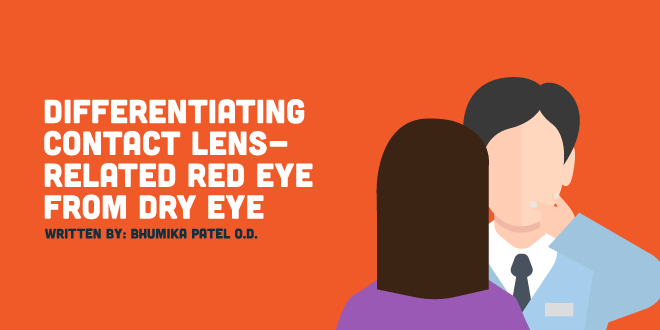How many red eye patients do you normally see in a week? I see about two to five on average. Some patients who come in with red eyes are contact lens wearers. It's important to distinguish an infection from inflammation secondary to dry eye, as an incorrect diagnosis can lead to delayed treatment.
Delayed or unsuccessful treatment might make patient seek a second opinion or lose confidence in you as their eyecare provider.
Let's look at a case of a red eye.
A 35 year-old caucasian female presented with red eyes that had been occurring on and off for a month. She reported discharge, eye discomfort, and an inability to wear contact lenses. She subsequently was diagnosed with giant papillary conjunctivitis (GPC) and had been medicated with: Pred Forte, Alrex and Lastacaft with slight improvement.
This particular patient presented to us for a second opinion. Since she was diagnosed with GPC already, I felt it important to examine the palpebral conjunctiva. On examination, there was 1+ papillae and a moderate amount of concretions. Concretions can form due to chronic inflammation related to conjunctivitis, dry eye or meibomian gland dysfunction.
I began her on a regimen of Alrex bid ou and Freshkote qhs ou to control the inflammation.
At her follow up visit, the GPC had resolved; however she still had concretions within the superior palpebral conjunctiva. Our patient also complained of having dryness in both eyes, so I investigated tear break up time (TBUT), which was 3 seconds OU and noted the presence of conjunctival staining.
Had I checked TBUT at her last visit, I could have addressed these findings and saved her another office visit. I changed the treatment regimen to include artificial tears QID OU, warm compresses BID OU and Restasis BID OU.
At the follow up visit, TBUT increased to 4 seconds and the size of concretions were reduced. She is scheduled for follow up again in several months.
It can oftentimes be difficult to differentiate between contact-lens related issues and dry eye as they can go hand and hand and present similarly.
Below I will outline several causes of red eye secondary to contact-lens related complications and dry eye, and how to differentiate between the two.
Giant Papillary Conjunctivitis
Signs: cobblestone papillae on upper lid, mucous discharge, contact lens intolerance
Treatment: discontinue contact lens wear, mast cell stabilize for mild-moderate cases, topical steroids for severe cases
Tip: Evert lids on all contact lens wearers even if they are asymptomatic.
Meibomian gland dysfunction (MGD)
Signs: capping of meibomian glands, hyperemia and telangiectasia of posterior lid margins, toothpaste like secretion on applying pressure to lid margin and oily tear film
Treatment: lid hygiene (warm compresses and digital massage of lids), Doxycycline 100mg bid for 6-8 weeks, artificial tears
Tip: Chronic MGD can lead to contact lens intolerance and giant papillary conjunctivits.
Aqueous Deficiency
Signs: foreign body sensation, dryness, watering, gritty feeling, contact lens intolerance
Treatment: artificial tears and ointment, Restasis, punctal plugs, mild topical steroid (I normally use FML BID OU for a month and then switch to Restasis).
If my patient was in pain and had photophobia, corneal ulcer and contact lens induced acute red eye would be on my differential diagnosis list as well.
Here is a
great article on the signs and treatment of some of these conditions.
With a red eye patient, it's important to look at the eyelids, conjunctiva, cornea and anterior chamber specifically if a patient is wearing contact lenses. With a right diagnosis and treatment, not only will your patient be happy, but you will also create a loyal patient to your practice.
What would you have done differently for this patient? Share your thoughts in the comments!
Tip: Check TBUT on patients who complain of watery eyes.
References
- Kanski, J. Clinical Ophthalmology A Systematic Approach. Elsevier, 6th edition, 2011
- Haicl, P., Jankova, H., & Jirsova, K. Dry eye syndromes in patients with conjunctival concretions. Cesk Slov Oftalmol. 2006 Nov. http://www.ncbi.nlm.nih.gov/pubmed/17319173
NEWGRADOPTOMETRY.COM DOES NOT PROVIDE MEDICAL ADVICE. Any and all information found on NewGradOptometry.com is intended as a general resource only and does not address individual circumstances. It is not a substitute for professional medical advice, diagnosis, or treatment and should not be relied on to make decisions about your health or that of your patients. It is not intended to be patient education and does not create a patient-physician relationship. Never disregard professional medical advice or delay seeking it because of something you have read on NewGradOptometry.com. Always seek the advice of your physician or other qualified health provider with any questions you may have regarding a medical condition. If you think you may have a medical emergency, immediately call your doctor or dial 911.
© 2016 NewGradOptometry, LLC. All rights reserved.
